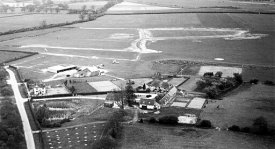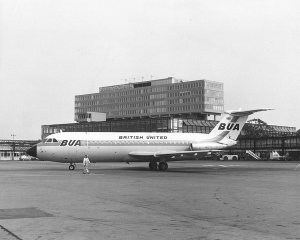
Gatwick Airport History
Gatwick was originally known as the Manor of Gatwick and was owned by the De Gatwicks. In the 14th Century the land was then divided up between various families.
- Serves
- Gatwick, London, UK
- Operator
- Ivy Bidco Limited, managed by Global Infrastructure Management, LLC, part of Global Infrastructure Partners (GIP)
- Telephone
- +44 (0)870 000 2468
- Time Zone
- Europe/London
- IATA Code
- LGW
- ICAO Code
- EGKK
- Location
- 051°08'53"N 000°11'25"W
It was not until 1890 that the area that Gatwick Airport lies on was purchased by the Gatwick Race Course Company. The race-course opened a year later in 1891 along with its own railway station. The race-course was opened to replace the one at Waddon, near Croydon, which was closed in 1891. During the First World War after the grand national race had been held in 1915, Aintree race-course was taken over by the war office, and it was impossible to hold the race there, so an alternative had to be found and the place that was eventually decided on was many of hundreds of miles to the south of the Liverpool venue, and after some discussions the race-course that stood on the ground where the Airport now stands in Gatwick was chosen. The final 'National' to be held at Gatwick was in 1917, and by now the race was becoming established and the winner was Poethlyn, he was ridden by Ernie Piggott the grand father of the very well known jockey Lester Piggott. As a pure coincidence to this story the land that was formerly Waddon Race-course then became part of Croydon Aerodrome, London's first airport.
In 1930 land alongside the race-course at Hunts Green Farm was purchased and used as a small aerodrome; licensed in August 1930 it was known as Gatwick Aerodrome and used by a small flying club the Surrey Aero Club. In just a year it was used by an increasing number of jockeys and race goers for the race meetings at the Gatwick Race Course.

The airport changed hands a number of times in the next few years and in 1933 was bought for £13,500 by Morris Jackaman who a year later formed Airports Limited. The Air Ministry also issued Gatwick with its first public license in this year 1934. A brand new railway station was opened in September 1935 and was served by two trains an hour running along the Victoria – Brighton line.
Hillman Airways was the first airline to operate out of Gatwick and flew to Belfast & Paris. It later merged with United Airways and Spartan Airways in 1935 to form Allied British Airways Limited.
In 1936 the world's first circular terminal 'The Beehive' was built and opened. The new train station was linked to 'The Beehive' with a 130 yard long subway. On 17 May 1936 the first scheduled flight to Paris departed costing just four pounds and 5 shillings, this included a first class train ticket from London, but in today's money would cost approx £161.00. Flights to other destinations were added and these included Hamburg, Copenhagen, Isle of White and Malmo via Amsterdam. Sadly later that year there were two fatal crashes at Gatwick and doubts were raised regarding its fog problem and poor drainage due to its heavy clay soils. In 1937 British Airways moved its operations from Gatwick back to Croydon.
Gatwick reverted back to private use and became the 19th Elementary and Reserve Flying Training School in the country, (a training school for the RAF). It was then requisitioned by the Air Ministry during the Second World War and its area was extended further by requisitioning part of the race-course also. Gatwick Airport was decommissioned after the war in 1946 but was retained and operated for civilian use by the Ministry of Civil Aviation to operate as a charter airport for a 6 month trial. It in fact took until 1952 for the Government to give approval for the proposed development of Gatwick as an alternative to Heathrow Airport.
Gatwick airport was then closed in March 1956 and building commenced for the new airport. At a cost of £7.8 million and 2¾ years later the New London Airport was built and Her Majesty The Queen officially opened Gatwick Airport on 9 June 1958. This airport was seen as a pioneer in its design with piers and gaterooms enabling passengers to wait in one area until called to board their plane instead of getting a bus or long walk to the aircraft.

Gatwick airport was the first airport in the world to integrate air, road and rail transport from one single unit.
Transair was the first operator out of Gatwick in 1958 In its first 7 months of operating 186,172 passengers had used the airport. In 1959 the figures had grown to 368,000, but these figures are still less than a busy weekend at South Terminal in 2003.
In 1962 work began in extending the airport. The terminal was doubled in size and a further two piers were built. In 1964 the runway was extended to 8,200 feet to enable Gatwick to accommodate the increasing number of jet aircraft. The runway was extended again in 1970 to 9,075 feet and again in 1973 to 10,165 feet. It is now 10,682 feet, (3,256 metres). In 1977 Pier two was completed and was further extended in 1984 to provide extra jetty-served stands.
In 1983 the new Satellite pier was opened. This replaced the old North Pier and incorporated the first rapid transit system outside the U.S. Also in 1983 work began on building a new terminal which also included the building of a second runway which was built as Gatwick's 'emergency runway'. The North Terminal as it is known was completed in 1988 at a cost of £200 million and was officially opened by Her Majesty The Queen and The Duke of Edinburgh. In 1991 a second pier was completed at the North Terminal serving stands for a further 11 aircraft. 1994 saw the new North Terminal International Departures lounge and phase 1 of the South Terminal Internationals departure lounge opened at a cost of £30 million.

In the 80s passenger figures reached 10 million and in 2000 reached over 32 million. Further expansion of both South and North terminals providing extra seating, shops and restaurants took place in 2000 & 2001 at a total cost of over £59 million.




